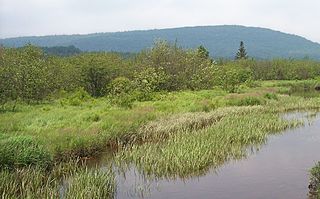
Shrub swamps — also called scrub swamps or buttonbush swamps — are a type of freshwater wetland ecosystem occurring in areas too wet to become swamps ("true" or freshwater swamp forest), but too dry or too shallow to become marshes.[1][2] They are often considered transitional ("mid-successional") between wet meadows or fens and conifer or hardwood swamps.
By some classifications,[which?] shrub swamps must have at least 50% shrub cover and less than 20% tree cover. Other definitions[which?] specify large shrubs with small trees less than 35 feet (11 m) in height. Creation of shrub swamps often follows a catastrophic event in a forested swamp (flood, cutting, fire, or windstorm). Another route of development is via drained meadows and fens which progress to shrub swamps as a transitional state to forested swamps.
- ^ KALLIOLA, RISTO; PUHAKKA, MAARIT; SALO, JUKKA; TUOMISTO, HANNA; RUOKOLAINEN, KALLE (1991). "The dynamics, distribution and classification of swamp vegetation in Peruvian Amazonia". Annales Botanici Fennici. 28 (3): 225–239. ISSN 0003-3847.
- ^ Johnson, Kurt; Walton, Gary; Johnson, Andrew (2010). "Wetland Mitigation in Abandoned Gravel Pits: Creating Fresh Meadow and Shrub Swamp". ISBN 978-0-9778094-4-8.
{{cite journal}}: Cite journal requires|journal=(help)
© MMXXIII Rich X Search. We shall prevail. All rights reserved. Rich X Search
